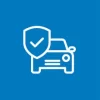Insurance is one of the costs you must deal with if you own a vehicle. Third-party liability car insurance is obligatory, and having partial-casco car insurance or full-casco car insurance car insurance can also be worth getting in some cases.
Car insurance has its price. According to Finma statistics, Swiss car owners collectively spent over 2.5 billion Swiss francs on third-party liability car insurance alone in 2023. Total spending for all car insurance types combined surpassed six billion francs in the same year.
Here, moneyland.ch lists 11 ways to lower your car insurance costs in Switzerland.
1. Avoid unnecessary insurance
Take time to think about which kind of car insurance you actually need. If you own an older car with a relatively low resale value, then getting partial or full-casco car insurance normally is not worth it. You only need passenger insurance if the people who ride in your car are not covered by accident insurance, which is mandatory for all residents. If your household insurance already adequately covers things that you carry with you in your car, then you do not need additional car insurance for the contents of your car.
If you already have a roadside assistance service (from a car dealer or motorist club, for example), then you do not need the roadside assistance rider for car insurance – though it can work out cheaper in some cases.
2. Compare insurance premiums
Many people have the idea that Swiss car insurance is generally expensive, and all Swiss insurance companies charge almost identical premiums. But that is not correct. The insurance premium for the most expensive offer can be as much as twice as high as the premium for the cheapest offer. Take time to compare the costs online and get quotes from several different insurance providers. Avoid contracts with a term longer than one year. If you tie yourself into a long-term insurance agreement, you will not be able to easily move to cheaper offers as they become available. You can compare premiums here.
3. Take advantage of membership discounts
If you have a membership in a motorist club, an industry association, or a labor union, then you may be able to claim car insurance discounts.
Unia, for example, offers its members a discount on car insurance from Smile Direct. Swiss Leaders (formerly the Schweizer Kader Organisation SKO) offers its members discounts on car insurance from Generali and Zurich.
Zurich offers discounted car insurance to members of Swiss homeowners’ association HEV and the teachers’ association Dachverbandes Lehrerinnen und Lehrer Schweiz (LCH). Holders of the Migrol Private Card gas card can get discounts on Generali car insurance. Many other employers and associations have similar partnerships with insurance companies, so checking whether any of your memberships entitle you to discounts is worth it.
4. Choose a higher insurance deductible
If you rarely or never claim on your insurance, but want financial protection for major unexpected expenses, you can save a lot of money by choosing a high insurance deductible. The higher the deductible, the lower the insurance premiums.
5. Attend defensive driving courses
Some Swiss insurance providers lower your premiums if you attend defensive driving courses.
Mobiliar, for example, not only discounts its car insurance when you attend a defensive driving course, but also contributes 100 francs towards the cost of the course. Helvetia too contributes towards the cost of defensive driving courses, and young drivers also benefit from a move to a higher bonus tier in Helvetia’s bonus-malus system for both third-party liability insurance and full-casco insurance. TCS rewards customers who complete defensive driving courses with discounts of up to 20 percent.
6. Choose your car carefully
Buying a car is often an emotional decision. But if you are not particularly into cars and simply want to get from A to B as cheaply as possible, then getting a car that has low insurance premiums can make financial sense.
In Switzerland, car insurance premiums are largely determined by the size of your engine. The smaller the motor, the lower the premiums are. Some insurance providers offer special discounts for economical cars, and vehicles that use alternative power sources, such as electric cars.
7. Use interchangeable license plates
In Switzerland, it is possible to use just one set of license plates for two different vehicles. If you own two cars, but do not use both of them at the same time, you can simply attach the interchangeable license plates to the vehicle that you are currently using. You only pay for mandatory third-party liability car insurance for the vehicle with the higher insurance premium. You do not need separate insurance for the second car.
If, for example, you use a small car for work during the week, and a larger car or camper on weekends, then you can simply move your license plates between your work and leisure vehicles. That cuts out the cost of liability insurance for one vehicle.
If you want partial-casco or full-casco car insurance, you will have to get separate insurance policies for each of your cars. These insurance types are worth getting for new or expensive cars, as they cover damages that occur while your car is parked as well as when it is driving. Some Swiss insurance providers give you a multiple-policy discount when you insure more than one car with them. Full-casco insurance is not obligatory, and normally does not pay off for vehicles with a low resale value.
8. Put unused license plates on hold
If you will not be using your car or motorcycle for a long period of time (during a longer holiday, trip, or in winter, for example), you can put your license plates on hold by depositing them at your local road traffic authority office. You are not required to have third-party liability insurance while your license plates are on hold.
Most Swiss car insurance providers will freeze your liability and collision (full-casco) insurance policies for as long as your license plates remain deposited. Helvetia and Zurich continue to cover your unused car against hazards that occur on private property for up to 12 months on a complimentary basis.
Mobiliar puts your car insurance policies on hold for up to nine months without charging premiums (except for possible administrative fees). Generali freezes your car insurance for up to six months, but continues to charge half of the premiums for partial-casco car insurance. Smile Direct discounts your partial-casco premiums by 50 percent and your liability and full-casco premiums by 100 percent while your license plates are on hold.
9. Drive carefully
Like many insurance companies, the majority of Swiss car insurance providers discount your insurance premiums when go for a certain amount of time without making a claim. These discounts normally only apply to the time during which you remain insured by the same insurance company. Just showing that you did not have accidents while you were insured by other companies typically does not qualify you for a discount.
Zurich reimburses young adults who do not make any claims for three years with 10 percent of the premiums they paid during that time. Most other insurance providers, including Allianz, Helvetia, and Smile Direct, use bonus-malus systems which raise or lower your premiums based on how often you make insurance claims.
10. Read the fine print
Before you get partial-casco insurance for your car, you should carefully check which hazards it actually covers. Some risks, like fire and hail, are covered by all Swiss car insurance providers. But other risks like vandalism and damages caused by animals are only covered by some partial-casco car insurance offers. Make sure to choose a car insurance provider that covers the damages which you are likely to encounter. While having the right insurance coverage may not lower the cost of insurance premiums, it can save you a lot of money if a hazard occurs.
11. Consider mileage-based models
Car insurance with mileage-based premiums has appeared in Switzerland in recent years. The My Way offer from Zurich Insurance and the Flexdrive offer from Simpego are two examples. With this model, the premiums you pay vary depending on how much you actually drive. If you only put relatively few kilometers on your odometer, on average, this insurance model can work out cheaper than flat, annual insurance premiums.
More on this topic:
Compare car insurance premiums now
Saving tips for car owners in Switzerland
Is underinsured motorist insurance worth getting?
A guide to using car plans in Switzerland


 Deal of the Day
Deal of the Day 









